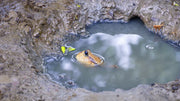
You glance out the kitchen window and feel your stomach drop—the waterline on your once-pristine pond sits a few inches lower than yesterday. Is it a sneaky leak or just another scorcher evaporating the surface? Before panic (or algae) sets in, follow this field-tested roadmap. You’ll confirm the problem, locate the culprit, choose the right pond leak repair method, and lock in long-term protection with smart waterproof gear like the Poposoap Pond Liner Geotextile and other weather-proof accessories.
Introduction: Is Your Pond Leaking?
All ponds lose water. Wind blows across the surface, splashing from waterfalls sails off as fine mist, and hot afternoons wick off a surprising amount of moisture. But when the drop accelerates—especially overnight—it’s time to investigate. Ignoring a leaking pond can drain thousands of gallons a month, collapse banks, fry pumps that run dry, and expose liner seams to UV damage. Worse, fish stress out as parameters swing. A deliberate troubleshooting process saves money, livestock, and Saturday afternoons better spent relaxing by the water.
Step 1: Confirm It’s a Leak, Not Evaporation
-
Measure precisely. Push a yardstick into the water beside a fixed rock or shelf and photo the reading. Check 24 hours later under similar weather. Normal evaporation is ⅛-¼ inch (3–6 mm) per day in mild climates; up to ½ inch (12 mm) during heat waves.

-
Bucket test: Fill a sturdy five-gallon bucket with pond water, mark the level, and set it on a shaded stone inside the pond (rim above waterline). After a day, compare drops. If the pond fell an inch while the bucket lost only ¼-inch, you almost certainly have a leak.
-
Isolate features: Turn off waterfalls, streams, and fountains but keep the main pump aerating in the deepest zone (fish first!). If losses slow, the plumbing or cascades—not the liner—are leaking.
Only after you’re certain the water loss exceeds evaporation should you tackle how to find a leak in a pond.
Step 2: Pinpoint the Leak Source
Surface to mid-depth leaks
Allow the pond to drop naturally until it stabilises. Wherever it stops is ground zero. Walk the perimeter at that level; look for damp soil, worm burrows, or liner folds pulling away. In rock-edged ponds, spillover points become obvious: algae patterns on stones just below the new “shoreline” tell stories.

Plumbing and waterfall leaks
With pumps off, inspect hose unions, bulkhead fittings, and UV-clarifier casings. Feel under cascading rocks for trickling water. A pencil-thin stream behind a waterfall may bypass the pond entirely. At night, use a flashlight behind features—the beam picks up tiny droplets you’ll miss by day.

Bottom leaks
If water continues falling to the last foot, suspect the deepest liner. Murky bottoms make visual checks tough. Instead, walk an inflatable inner tube across the floor feeling for soft spots or rodent tunnels. When in doubt, drain and use milk powder in water around suspected seams—the cloud will dart into holes, flagging the breach.
Remember: patience beats brute force. Document each stage so you won’t reopen finished sections later.
Step 3: Repair Options Based on Type of Leak
Tiny liner punctures (< ½-inch).
-
Clean and dry the spot.
-
Apply a peel-and-stick EPDM or PVC patch designed for pond liners. Warm it with a hair dryer to improve adhesion, then roll firmly.
-
Reinforce with an underwater sealant bead around edges.
Seam separation or large tears.
-
Use a seaming tape system: primer, double-sided tape, then top lap tape.
-
For really shredded corners, splice in a new panel of Poposoap Pond Liner Geotextile—its reinforced fabric resists roots and critter claws better than thin DIY sheeting.
Perimeter settlement (water escaping over the edge).
-
Lift perimeter stones, add compacted soil or crushed granite beneath, reset rock cap.
-
Tuck a 6-inch strip of the Poposoap geotextile under the liner to create a firmer foundation.
Plumbing pinholes.
-
Replace brittle PVC or use a flexible rubber repair coupler tightened with stainless clamps.
-
Where tubing exits the pond wall, coat the bulkhead flange with pond-safe polyurethane sealant.
Waterfall weeps.
-
Pull forward the face rock, brush out sludge, and paint a thin layer of liquid rubber membrane on the mortar ledge.
-
Backfill behind the cascade with expanding pond foam to force water forward over the spillway instead of under it.
Concrete ponds.
-
Hairline cracks patch well with hydraulic cement mixed with latex binder. For wider fractures, chisel a “V” groove first for bond.
-
After curing, roll a two-part epoxy pond paint over the shell.
Throughout repairs keep circulation running with a temporary pump such as the Poposoap 10-Watt Solar Fountain Pump clipped to a milk crate—cord-free, quiet, and perfect for emergency aeration when the main system is dry.
Preventing Future Pond Leaks
-
Lay a quality liner once. The Poposoap Pond Liner Geotextile comes in pre-calculated sizes (their catalog even includes area formulas) and features UV-stable fabric laminated to EPDM—tougher than cheap PVC sheets.
-
Pad under big rocks. Slide scrap liner or foam under boulders to distribute weight.
-
Shield against roots. Aggressive willow, bamboo, or reed roots can puncture liners; install a vertical root barrier on the shore side before planting.
-
Protect plumbing. Run hoses inside PVC conduit or bury at least 6 inches deep so frost heave and critters can’t nip them.
-
Control wildlife diggers. Hardware-cloth skirts under the liner’s beach edge stop muskrats and raccoons from tunneling.
-
Monitor water parameters. Acidic water (pH < 6) can degrade concrete and some rubber; a weekly test kit is cheaper than replacing walls.
-
Keep circulation balanced. A Poposoap Floating Pond Fountain or Waterfall Kit returns water directly to the pond, preventing micro-channels that sneak out the back of cascades.
-
Do seasonal inspections. Each spring walk the rim for frost-raised rocks and each fall flush plumbing before freeze-up.
Conclusion: Detect Early, Fix Quickly
(Combine DIY with Poposoap waterproof products for peace of mind)
A leaking pond needn’t spiral into a full rebuild. By confirming loss vs. evaporation, narrowing the source, and choosing repairs matched to the specific failure, you’ll solve 90 percent of problems in a single weekend. Layer in protection—Poposoap’s rugged Pond Liner Geotextile beneath heavy rock work, solar pumps to keep life support running during drain-downs, and well-placed waterproof sealants—and you transform “yet another chore” into a quick, confidence-building upgrade.
Water will always test its boundaries; your job is simply to stay one step ahead. Follow these tips and your water garden will remain watertight, healthy, and soothing—exactly the oasis you envisioned.







